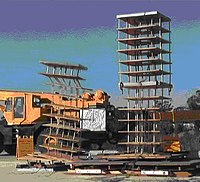
Photo from wikipedia
Abstract This paper presents an interdisciplinary study of the spatiotemporal dynamics of seismic exposure. Out of the three components of risk—hazard, exposure, and vulnerability—exposure is the least studied, and is… Click to show full abstract
Abstract This paper presents an interdisciplinary study of the spatiotemporal dynamics of seismic exposure. Out of the three components of risk—hazard, exposure, and vulnerability—exposure is the least studied, and is commonly treated as being constant in time. This approach neglects the dynamics associated with rapid development and urbanization, misrepresenting exposure in risk assessments. In this paper, mixed research methods are used to understand the dynamics of exposure in Santiago, the capital of Chile, between 1992 and 2017. First, residential exposure is modelled for three epochs using census data and public databases. Then, semi-structured interviews are conducted with local experts in engineering, planning, and disaster risk reduction to unveil the role of earthquake risk information in urban policy and development. Results show a steady expansion and densification of the city over the last 25 years, which is expected to continue in the future. The preferred building material for this growth is reinforced concrete, which rises from 3 to 17% as a proportion of the total structures in the city. It is also found that urban planning policy is disconnected from earthquake risk, which is perceived as a non-issue due to high local compliance with seismic codes. Thus, the continuous growth and homogenization of the built environment creates a singular dependence and blind trust in the local seismic academic and professional communities to provide earthquake resilience through safe buildings. These conditions configure a fragile but highly enabling environment for increasing seismic resilience in the city.
Journal Title: International journal of disaster risk reduction
Year Published: 2020
Link to full text (if available)
Share on Social Media: Sign Up to like & get
recommendations!